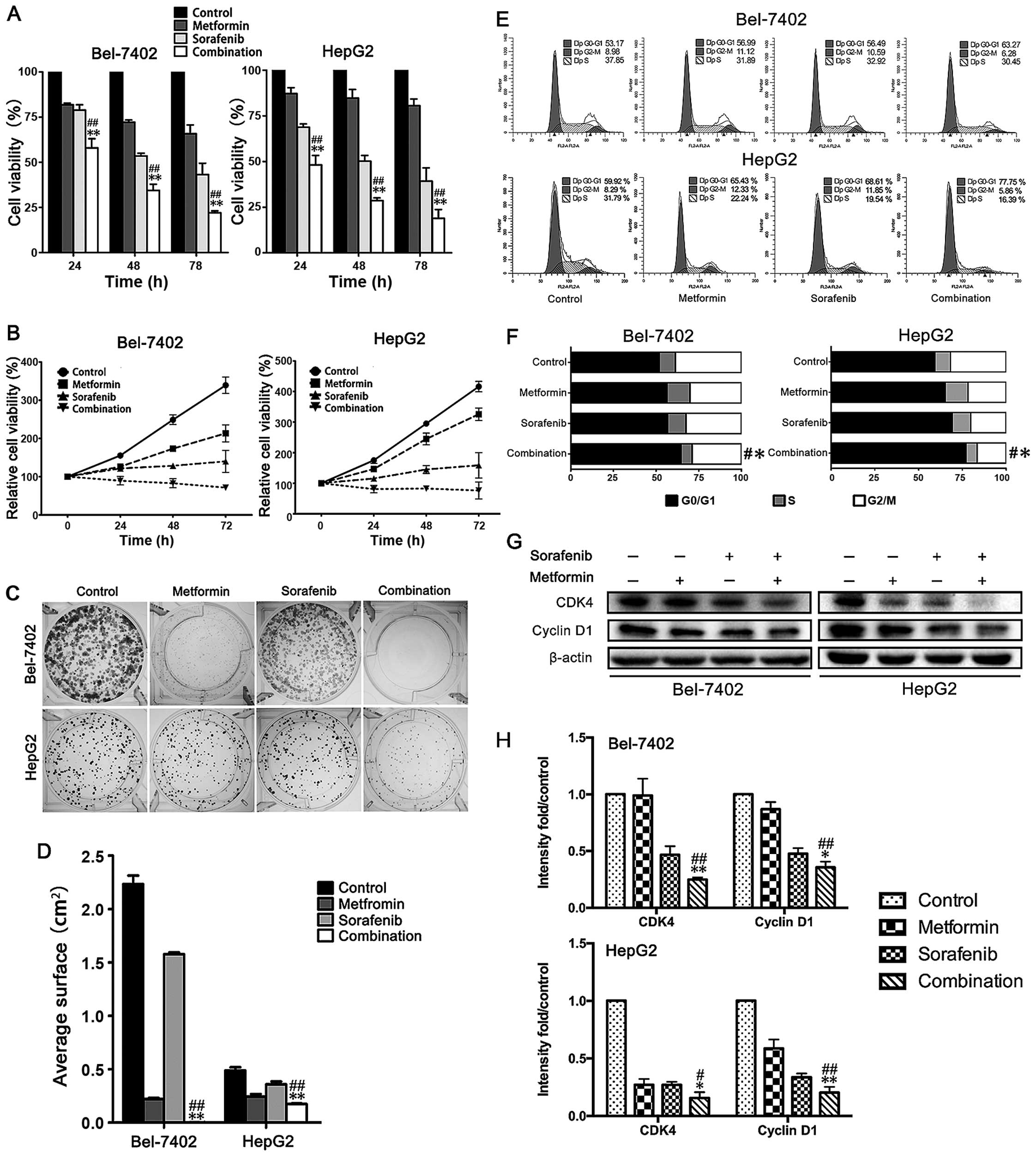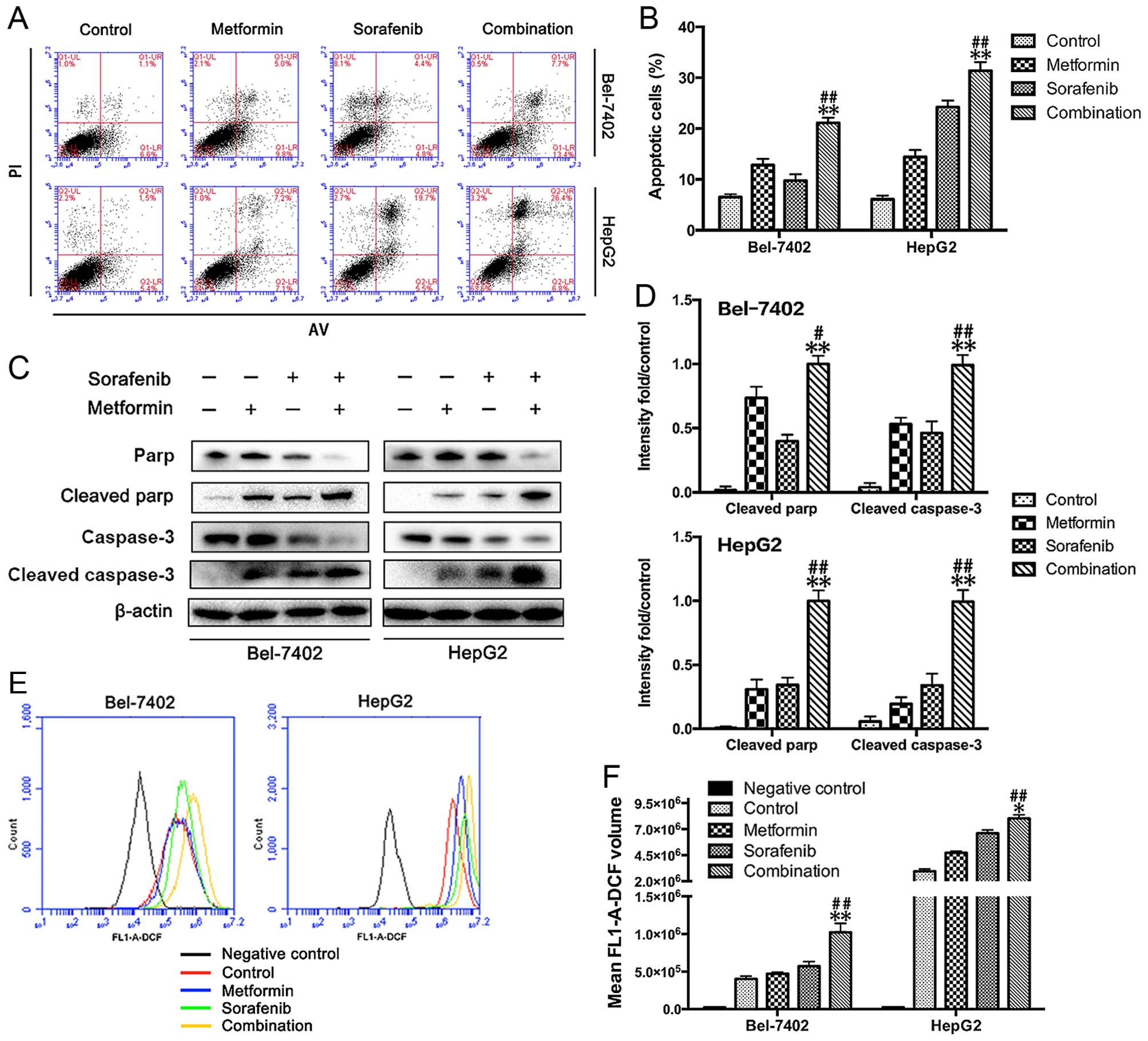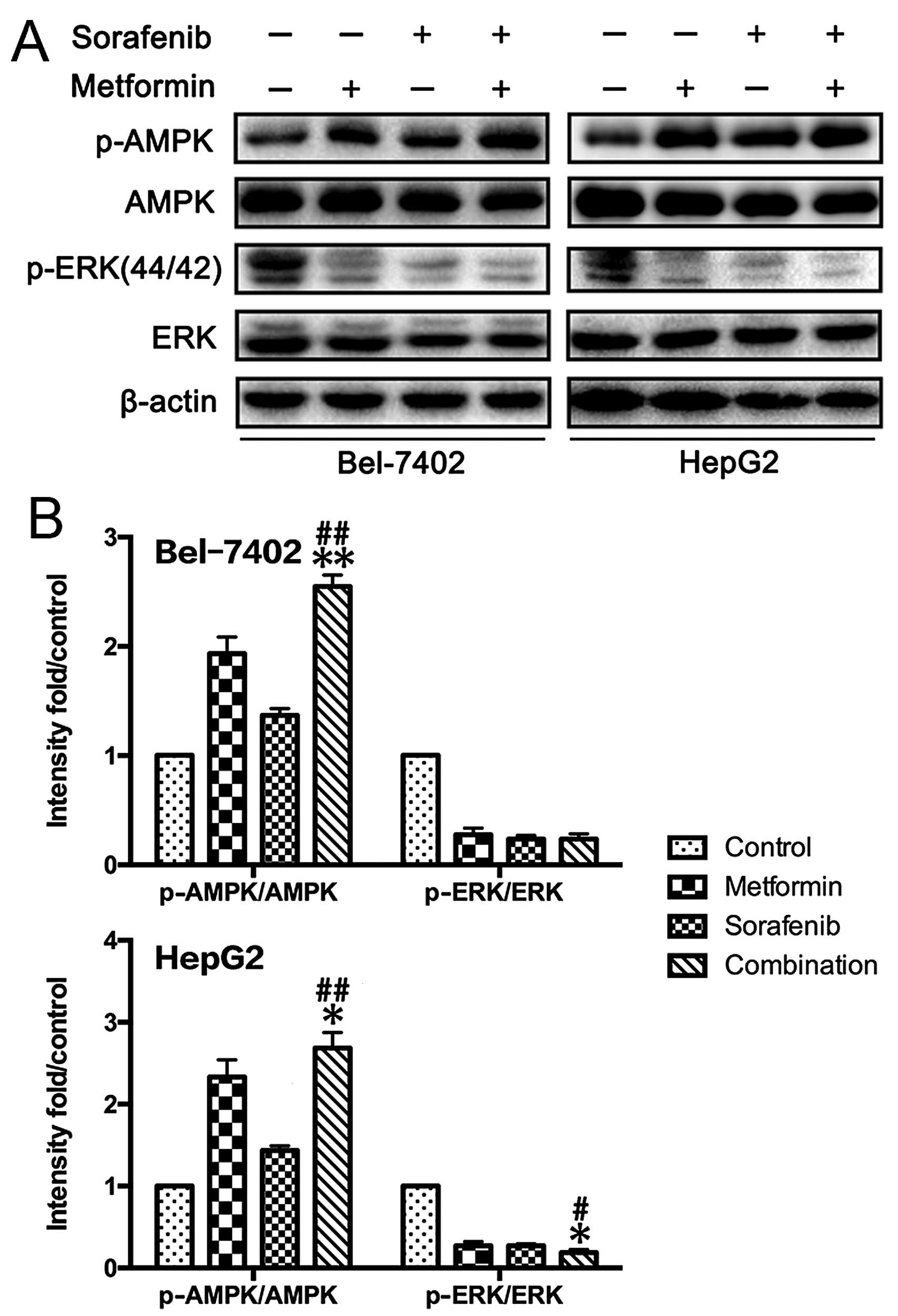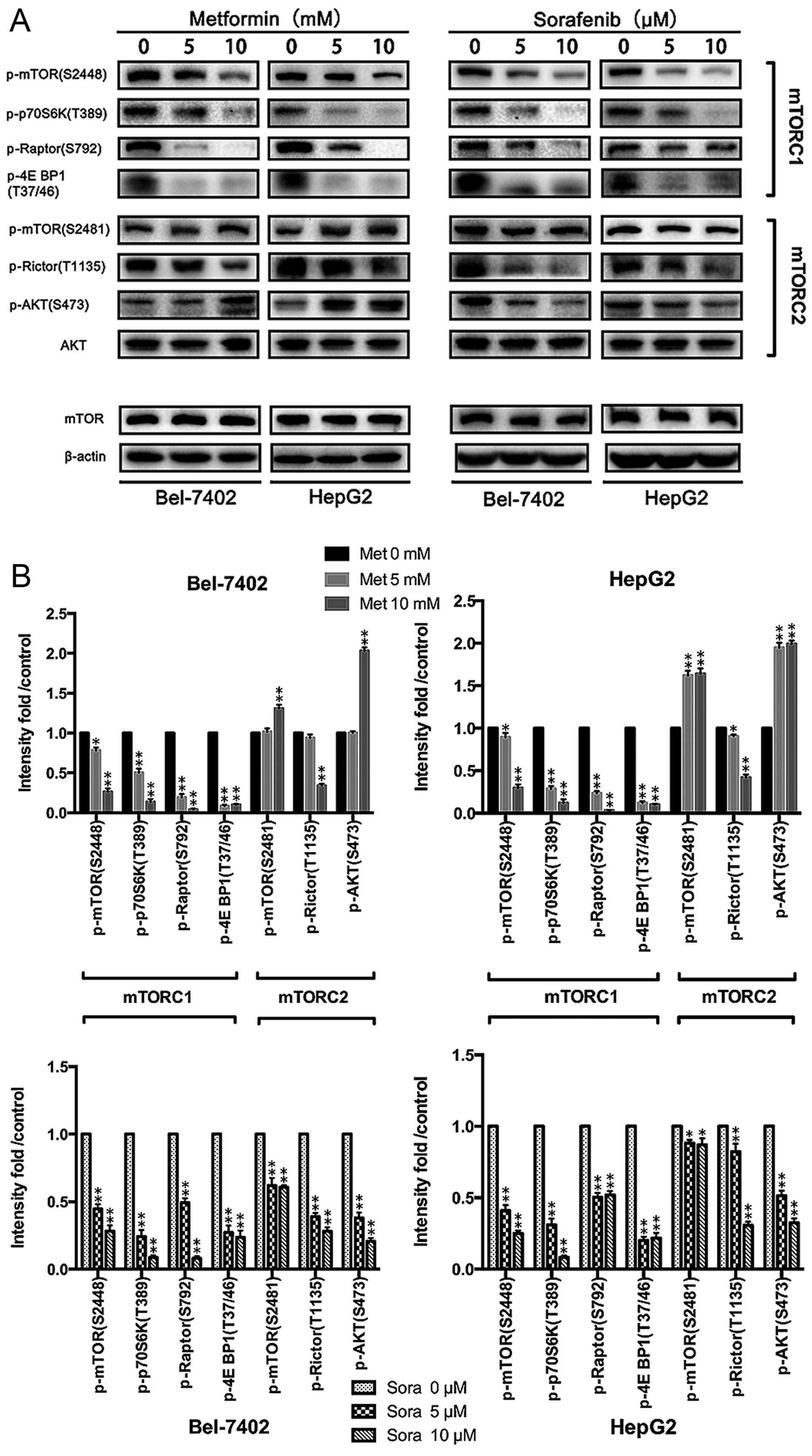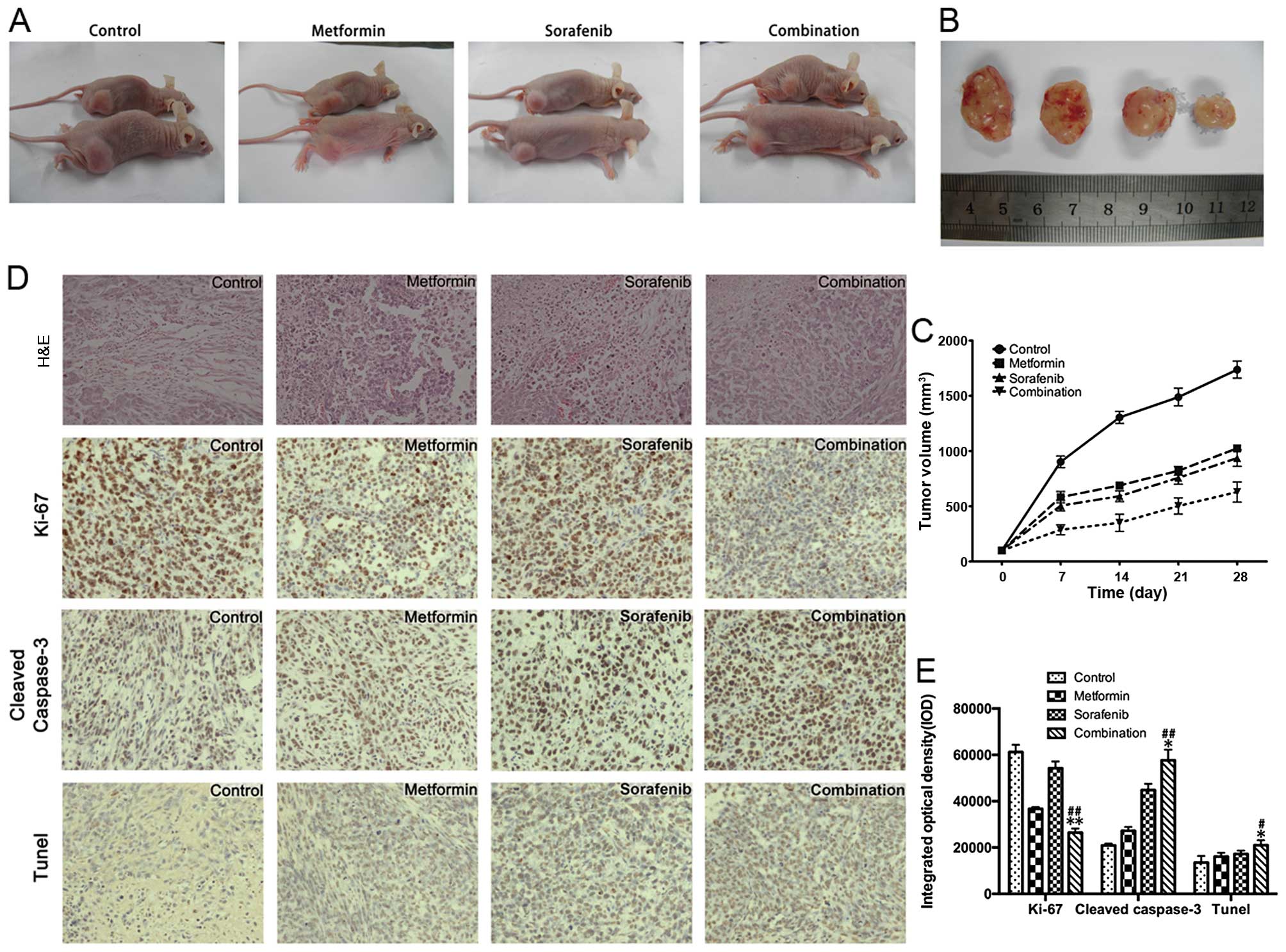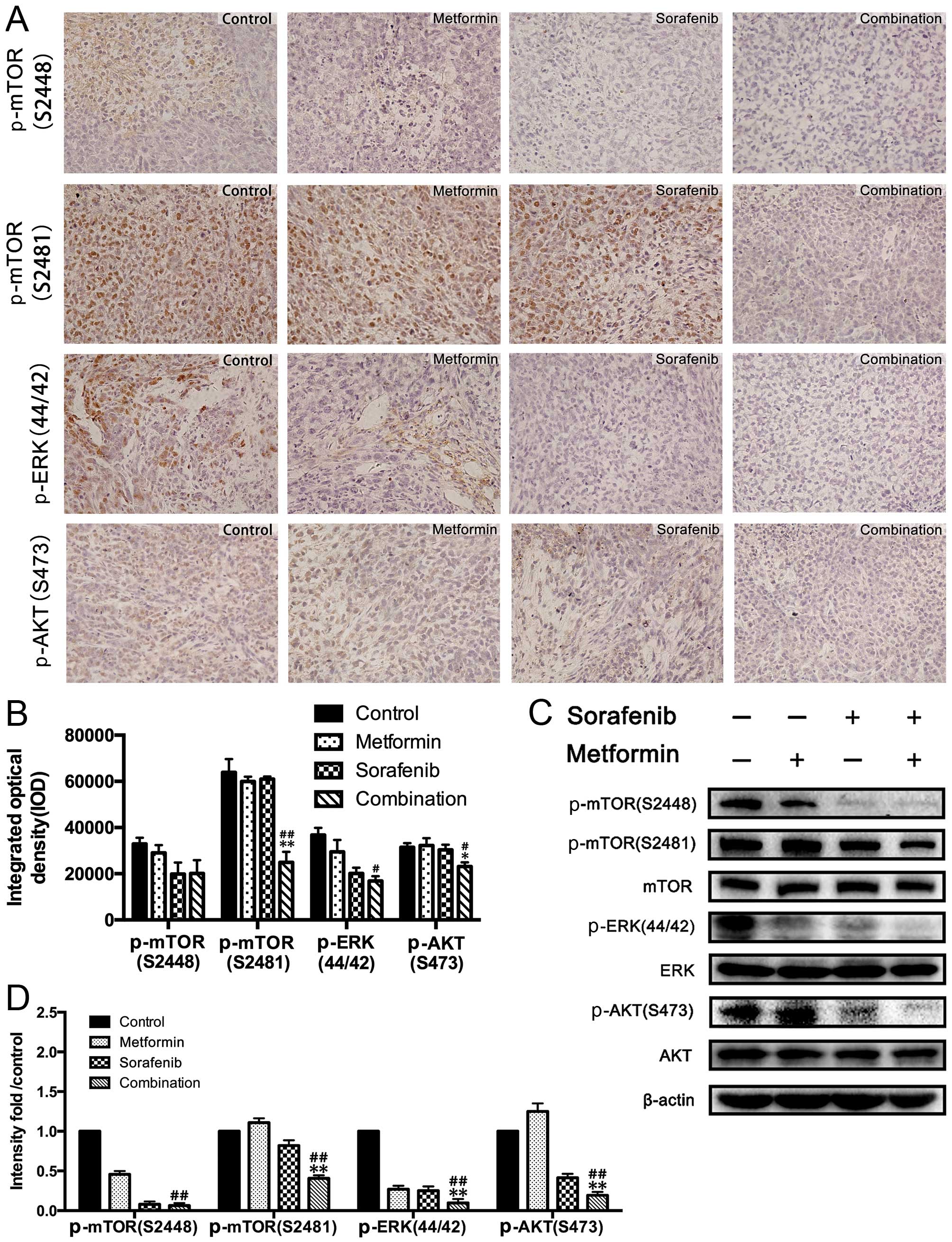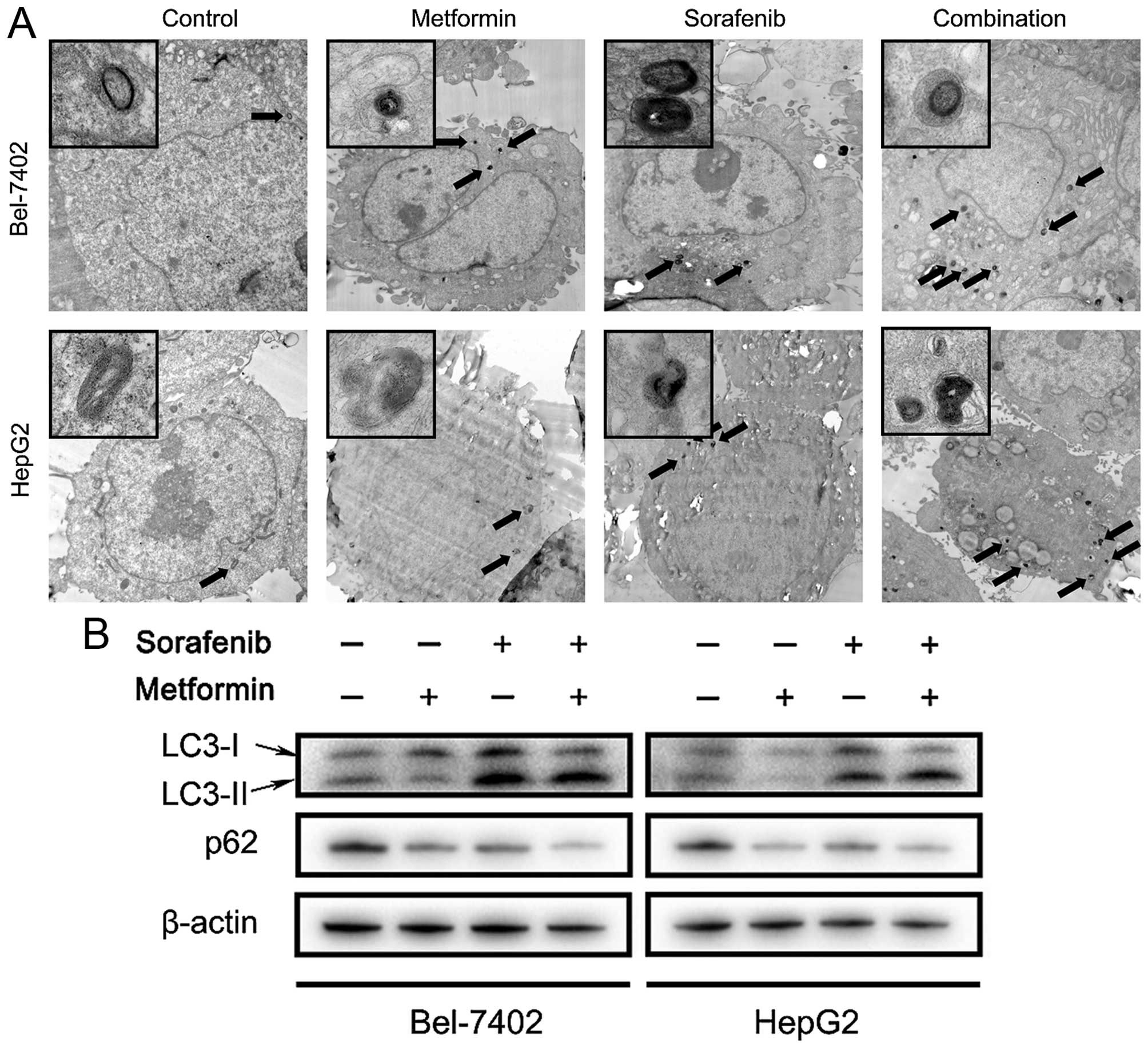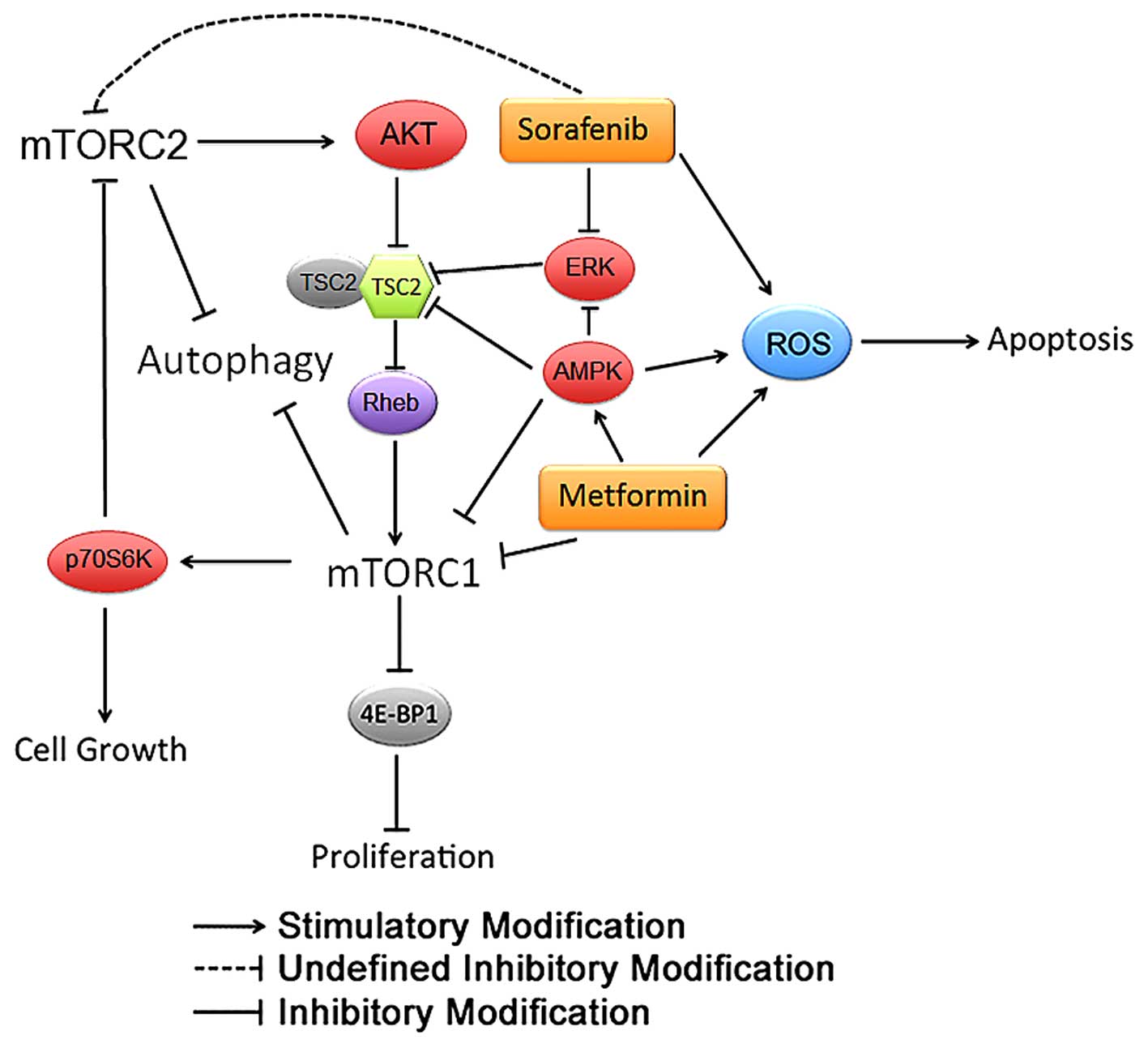Combination of metformin and sorafenib suppresses proliferation and induces autophagy of hepatocellular carcinoma via targeting the mTOR pathway
- Authors:
- Published online on: December 9, 2016 https://doi.org/10.3892/ijo.2016.3799
- Pages: 297-309
Abstract
Introduction
Liver cancer is one of the most common cancers and the third major cause of cancer-related mortality worldwide (1,2). As a major histological subtype, hepatocellular carcinoma (HCC), account for 70 to 80% of primary liver cancers (3). Despite improvements in clinical treatments, such as surgical resection, liver transplantation and interventional therapy, HCC prognoses remain very poor (1).
Conventional chemotherapies for liver cancer are generally ineffective and the multi-kinase inhibitor sorafenib is the only drug for which randomized control trials have shown an improved survival in advanced HCC (4). Sorafenib inhibits tumor growth through inducing tumor cell apoptosis by suppressing the kinase activity of Raf, an enzyme of the mitogen-activated protein kinase (MAPK) signaling pathway. In addition, sorafenib inhibits VEGF receptor (VEGFR) and platelet-derived growth factor receptor-β (PDGF-β) signaling to block tumor angiogenesis (5). However, sorafenib is proved to merely extend the life expectancy of patients with HCC by a few months (4,6) because of the heterogeneity of HCC. Therefore, sorafenib is insufficient to suppress HCC for both primary and secondary drug resistance.
Metformin, a first-line oral anti-type II diabetes agent used worldwide, suppresses tumorigenesis, according to recent epidemic and laboratory studies (7,8). Various explanations for the efficacy of metformin have been proposed, such as the activation of AMPK and the inhibition of insulin-like growth factor signaling and the mammalian target of rapamycin (mTOR) pathway (9). In patients with type II diabetes mellitus, metformin reduced HCC risk and seemed to suppress HCC development (10). In our previous studies, we explored the anti-proliferative effect of metformin in intra-hepatic cholangiocarcinoma (ICC) cell lines (11). Metformin may enhance the chemosensitivity of ICC to sorafenib by targeting the AMPK/mTOR complex 1 pathway and the MAPK pathway. In addition, metformin reversed multi-drug resistance (MDR) in the HCC BEL/FU cell line by targeting mTOR/HIF-1α/p-gp/MRP1 (12).
Agent combination based chemotherapy is common used for cancer patients. To develop a novel approach to benefit sorafenib based HCC treatment, we designed this study to evaluate the therapeutic effects and the underlying molecular mechanisms of a combined sorafenib and metformin treatment in a series of pre-clinical studies.
Materials and methods
Reagents
1,1-Dimethylbiguanide hydrochloride (metformin, #D150959-5G), chloroquine (CQ, #C6628) and 3-methylad-enine (3MA, #M9281) was purchased from Sigma-Aldrich (St. Louis, MO, USA); sorafenib (C21H16ClF3N4O3C7H8O3S, CAS 475207-59-1) was purchased from Selleck Chemicals (Houston, TX, USA); and the cell counting kit-8 (CCK-8, KGA317), the Annexin V-FITC apoptosis detection kit (KGA108), the terminal deoxynucleotidyltransferase-mediated deoxyuridine triphosphate (dUTP) nick-end labeling (TUNEL) assay kit (KGA707), the cell cycle detection kit (KGA512) and the ROS detection kit (KGT010) were purchased from KeyGen Biotech (Nanjing, China). The Histostain™-Plus kits (IgG/Bio, S-A/HRP, DAB) were purchased from Zhongshan Golden Bridge Co., Ltd. (Beijing, China).
Cell culture
The HCC cell lines Bel-7402 and HepG2 were purchased from the Type Culture Collection of the Chinese Academy of Sciences (Shanghai, China). The cell lines were cultured in RPMI-1640 supplemented with 10% fetal bovine serum (FBS) (both from Gibco, Carlsbad, CA, USA) and 100 µg/ml each of penicillin and streptomycin (Invitrogen, Carlsbad, CA, USA) in 5% CO2 at 37°C.
Antibodies
The following antibodies were used in western blot analysis: β-actin (sc-47778, diluted 1:1,000) was from Santa Cruz Biotechnology, Inc. (Santa Cruz, CA, USA). AKT (ab126811, diluted 1:1,000) and phosphorylated AKT (phospho-Ser473, ab66138, diluted 1:1,000) were from Abcam (Cambridge, MA, USA). Caspase-3 (AP7563C, diluted 1:1,000), cleaved caspase-3 (AJ1131b, diluted 1:1,000), CDK4 (AP7520b, diluted 1:1,000) and cyclin D1 (AP2612c, diluted 1:1,000) were from Abgent (San Diego, CA, USA). AMPKα (#2532, diluted 1:1,000) and phosphorylated AMPKα (phospho-Thr172, #2535, diluted 1:1,000), mTOR (#2983, diluted 1:1,000), phosphorylated mTOR (phospho-Ser2448, #5536, diluted 1:1,000), phosphorylated mTOR (phospho-Ser2481, #2974, diluted 1:1,000), phosphorylated Raptor (phospho-Ser792, #2083, diluted 1:1,000), phosphorylated p70 S6 kinase (phospho-Thr389, #9234, diluted 1:1,000), phosphorylated 4E-BP1 (phospho-Thr37/46, #2855, diluted 1:1,000), PARP (#9532, diluted 1:1,000), cleaved PARP (#5626, diluted 1:1,000), ERK (#4696, diluted 1:2,000), phosphorylated ERK (phospho-Thr202/Tyr204, #4370, diluted 1:2,000), Ki-67 (#9449, diluted 1:1,000), LC3-I/II (#12741, diluted 1:1,000) and p62 (#8025, diluted 1:1,000) were from Cell Signaling Technology, Inc. (Danvers, MA, USA). Goat anti-rabbit and goat anti-mouse IgG peroxidase-conjugated secondary antibodies (31460 and 31430, both diluted 1:10,000) were from Thermo-Pierce (Rockford, IL, USA). The following antibodies used in the IHC assays were as described above: phosphorylated mTOR (phospho-Ser2448, diluted 1:200), phosphorylated mTOR (phospho-Ser2481, diluted 1:200), phosphorylated AKT (phospho-Ser473, diluted 1:200), phosphorylated ERK (phospho-Thr202/Tyr204, diluted 1:200), cleaved caspase-3 (diluted 1:200), and Ki-67 (diluted 1:200).
Cell viability assay
Cell viability was determined using the CCK-8 assay according to the manufacturer's instructions. Cells (5×103) were seeded into a well of a 96-well plate and cultured in 100 µl of RPMI-1640 supplemented with 10% FBS, 100 µg/ml penicillin and 100 µg/ml streptomycin. After 24 h, the agents (10 mmol/l metformin and/or 5 µmol/l sorafenib) was added to the culture medium. After the cells were incubated at 37°C for different times (24, 48 or 72 h), the medium was changed for 100 µl of RPMI-1640 and 10 µl of CCK-8 reagent. The cells were incubated for 2 h at 37°C. Finally, the optical density was measured using an EnSpire™ 2300 Multilabel Reader (Perkin-Elmer, Waltham, MA, USA) at 450 nm. Five replicates were prepared for each condition. The mean values were calculated and growth curves were drawn.
Clonogenic assay
The inhibitory effect of metformin and sorafenib on HCC cell proliferation was also determined by clonogenic assay. Logarithmic-phase HCC cells were trypsinized and collected, and the resuspended cells were seeded into 6-well plates in triplicates at a density of 500 cells/well in 2 ml of medium containing 10% FBS. After a 24 h incubation, the cultures were replaced with fresh medium containing 2% FBS and 5 mmol/l metformin, 2.5 µmol/l sorafenib or their combination and grown for 10 days. The cell clones were stained with a solution containing 1% crystal violet and 25% methanol for 2 min. The excess dye was removed by gently rinsing with tap water for 15 min. The average surface of the clones was determined by Image Pro Plus 6.0 software.
Western blot analysis
Cells after different treatments or tumor tissues from xenografts were harvested and lysed in RIPA buffer (KGP702) supplemented with 1 mM phenylmethylsulfonyl fluoride (PMSF; KGP610) and 1 mM phosphatase inhibitor cocktail (KGP602; all from KeyGen Biotech). The mixture was centrifuged at 12,000 × g for 20 min and the supernatant was collected. The protein concentration was determined using the BCA assay kit (KGPBCA) and each sample contained 30 µg protein per 10 µl. The protein samples were mixed with loading buffer (KGP101) and the proteins were separated using 6, 8 or 10% sodium dodecyl sulfate-polyacrylamide gel electrophoresis (SDS-PAGE) followed by transfer to polyvinylidenedifluoride (PVDF) membranes (Bio-Rad Laboratories, Hercules, CA, USA). After soaking in blocking buffer for 2 h, the blots were incubated with the primary antibody with gentle agitation overnight at 4°C and were subsequently incubated at 37°C for 1 h with the HRP-conjugated secondary antibody. The bands were visualized by chemiluminescence, imaged using a ChemiDoc XRS and analyzed using Image Lab (both from Bio-Rad).
Cell cycle, apoptosis and ROS evaluation
To evaluate the effects of metformin on cell cycle arrest, induction of apoptosis and intracellular ROS, the cells were examined using the cell cycle detection kit, the Annexin V-FITC apoptosis detection kit and the ROS detection kit, respectively, according to the manufacturer's protocols. Bel-7402 and HepG2 cells were seeded into 6-well plates (5×104 and 1×105 cells/dish for analysis of cell cycle arrest and apoptosis, respectively) and incubated for 24 h. For cell cycle analysis, after treatment with agents for 48 h, a total of 1×106 cells was pelleted by centrifugation and washed twice with PBS. Then, the cell pellets were resuspended in 500 µl of ice-cold 70% ethanol and incubated at 4°C overnight. The fixed cells were centrifuged and the pellets were washed with PBS. After incubation with 100 µl RNase A (10 µg/ml) for 30 min at 37°C in the dark, the cells were resuspended in 400 µl propidium iodide (PI) (50 µg/ml) and placed at 4°C in the dark for 30 min. The stained cells were analyzed using an Accuri C6 flow cytometer (Accuri Cytometers Inc., Ann Arbor, MI, USA).
For the apoptosis analysis, the cells were trypsinized, washed with cold PBS and suspended in PBS. Then, the cells were stained using the Annexin V-FITC reaction reagent (5 µl of Annexin V-FITC, 5 µl of PI) at 37°C for 30 min in the dark. The stained cells were analyzed using an Accuri C6 flow cytometer (Accuri Cytometers Inc.).
For the detection of intracellular ROS, an oxidation-sensitive fluorescent probe (DCFH-DA) was used. After treatment with agents for 24 h, a total of 1×106 cells was trypsinized and pelleted by centrifugation and washed twice with PBS. Then, the cell pellets were resuspended in 1 ml RPMI-1640 (serum-free) with 10 µm/l DCFH-DA and incubated for 20 min at 37°C. The positive control was treated with Rosup according to the manufacturer's protocol (data not shown). The stained cells were analyzed using an Accuri C6 flow cytometer (Accuri Cytometers Inc.). The FL1-A received the fluorescence induced by DCF. For each sample, 20,000 events were collected.
Xenograft model analysis
To investigate the anti-proliferative effect of metformin and sorafenib in combination on HCC cells in vivo, a nude mouse model bearing HCC cell xenografts was established. Five-week-old male athymic nude mice were obtained from the Animal Facility of Dalian Medical University. The mice were maintained under pathogen-free conditions and were provided with sterilized food and water. First, 5×106 Bel-7402 cells were injected subcutaneously into the right flank near the hind leg of each nude mouse. When the mice bore palpable tumors (the tumor volume was ~100 mm3), they were randomly divided into control [100 µl normal saline (NS) by intraperitoneal injection plus 100 µl 1% dimethyl sulfoxide (DMSO)] and 0.5% carboxymethyl cellulose [(CMC)-Na sterile water), metformin (200 mg/kg/day by intraperitoneal injection plus 100 µl 1% DMSO and 0.5% CMC-Na sterile water)], sorafenib (30 µg/kg/day by intragastric administration plus 100 µl NS by intraperitoneal injection) and combination (metformin, 200 mg/kg/day by intraperitoneal injection plus sorafenib 30 µg/kg/day by intragastric administration) groups (n=6 animals/group). The treatments were performed for 4 weeks, 5 times/week. The tumor volume was detected every week and was calculated by the following formula: volume = 1/2 (length x width2). After 4 weeks, the mice were euthanized and the tumors were isolated.
Immunohistochemical staining
The tumors isolated from the mice were paraffin-embedded and cut into 10 µm sections in a microtome cryostat (HM 500 OM; Carl Zeiss, Jena, Germany). Immunohistochemical staining was conducted according to the manufacturer's protocols for the Histostain™-Plus kits. Primary antibodies (as described in the antibodies section) were incubated at 4°C overnight. Images were captured with a light microscope (Axiolab; Carl Zeiss) and 5 images/sample were prepared. The Image-Pro Plus 4.5 software was used to analyze the staining data.
TUNEL assay
In situ detection of apoptotic cells in the tumors isolated from the mice was performed by TUNEL assay. The tumors were paraffin embedded and cut into 10 µm sections in a microtome cryostat (HM 500 OM; Carl Zeiss). The TUNEL assay was conducted according to the manufacturer's protocols. 3,3-diaminobenzidine (DAB) was used as the substrate for the peroxidase. The images were captured with a light microscope (Axiolab; Carl Zeiss) and 5 images/sample were prepared. Image-Pro Plus 4.5 software was used to analyze the staining data.
Autophagy analysis by transmission electron microscopy
HCC cells were harvested by trypsinization and fixed by immersion in 2.5% glutaraldehyde in 0.1 ml phosphate buffer (pH 7.4). The cells were then post-fixed in 1% osmium tetroxide, dehydrated in a graded series of ethanol and embedded in epoxy resin. The cells were sliced into 1 µm sections and stained with 0.2% lead citrae and 2% uranyl acetate. Representative areas were chosen for ultra-thin sections to view with a Tecnai Spirit electron microscope.
Statistical analysis
SPSS 13.0 statistical software was used for the statistical analysis. The values are presented as the mean ± SD. Statistical analyses were performed using Student's t-test. The analysis of multiple groups was performed with ANOVA with an appropriate post-hoc test.
Results
Combined treatment of metformin with sorafenib induces impaired proliferation as well as cell cycle arrest in HCC
The effect of a combination treatment of metformin and sorafenib on HCC proliferation was investigated in Bel-7402 and HepG2 cells using CCK-8 and clonogenic assays. The CCK-8 assay revealed a much stronger inhibitory effect of the combination than any single drug treatment for 3 days (Fig. 1A and B). A comparable defect was detected in single cell colony formation (Fig. 1C and D). Over a 10-day treatment, although metformin and sorafenib suppressed single cell colony progression, the combination almost eliminated colony formation. Next, we performed cell cycle analysis. A significant increase in the number of cells arrested in G0/G1 phase was observed in Bel-7402 and HepG2 cells with a combined treatment of metformin and sorafenib compared to the single drug treatment (Fig. 1E and F). Consequently, cyclin D1 and CDK4, the key regulators for G0/G1 to S phase transition, were further reduced in Bel-7402 and HepG2 cells (Fig. 1G and H) by the combined treatment when compared to the any single treatment. Remarkably, 10 mmol/l metformin and 5 µmol/l sorafenib were used for the CCK-8 assay and 5 mmol/l metformin and 2.5 µmol/l sorafenib were used for the clonogenic assay which are described in the figure legends. We had used the same drug concentration of CCK-8 assay in clonogenic assay, but no clones grew (data not shown). Thus, we think the lower cell concentration may increase the sensitivity of HCC cells to metformin and sorafeinib and we decreased the drug concentration in clonogenic assay. So the different drug concentration may be responsible for the different results between CCK-8 and clonogenic assay. Collectively, these results revealed that a combined treatment of metformin and sorafenib remarkably promotes anti-proliferative effects and G0/G1 cell cycle arrest in HCC cells.
Metformin facilitates sorafenib-induced apoptosis in HCC cells through promoting ROS production
Apoptosis is an underlying antitumor mechanism for both metformin and sorafenib. Here, we investigated the effects of the combined treatment on apoptosis in Bel-7402 and HepG2 cells. The apoptosis assay (Annexin V/PI staining), as shown in Fig. 2A and B, revealed a significant increase in the number of apoptotic cells observed in Bel-7402 and HepG2 cells with a combined treatment of metformin and sorafenib compared to the single drug treatment. To confirm these results, we performed western blot analysis and found increased expression of cleaved PARP and cleaved caspase-3 in both metformin- and sorafenib-treated Bel-7402 and HepG2 cells. Consistent with the greater apoptotic events, the combined treatment led to higher levels of cleaved PARP and cleaved caspase-3 in both Bel-7402 and HepG2 cells compared to single drug treatment alone (Fig. 2C and D). As sorafenib can induce mitochondrial-dependent ROS production, which elicits cell death in hepatomas (13), we next determined the influence of metformin on sorafenib-induced ROS production. As expected, data in Fig. 2E and F present that metformin (10 mmol/l) was readily to promote sorafenib (5 µmol/l) induced ROS production.
Metformin and sorafenib regulate the AMPK/ERK and mTORC1/2 pathways
To analyze the potential molecular mechanism, we investigated the effects of metformin and sorafenib on the AMPK/ERK and mTOR pathways in HCC cells (Fig. 3). Both metformin (10 mmol/l) and sorafenib (5 µmol/l) activated AMPK and inhibited ERK compared to untreated HCC cells. At concentrations of 0, 5 and 10 mmol/l, metformin significantly inhibited the mTORC1 (p-mTOR Ser2448, p-p70S6K Thr389, p-Raptor Ser792, p-4E BP1 Thr37/46) but activated the mTORC2 (p-mTOR Ser2481, p-Rictor Thr1135, p-AKT Ser473) (Fig. 3) pathway. Inconsistent results were obtained after sorafenib treatment, which suppressed the activation of both the mTORC1 and the mTORC2 pathway in HepG2 and Bel-7042 cells (Fig. 4A and B). The consequences of the combination of metformin and sorafenib on mTOR1/2 networks was further investigated, revealing that sorafenib reversed the activation status of mTORC2 induced by metformin and enhanced the suppression of mTORC1 by metformin in HCC cells (Fig. 4C and D). This result may explain the additional reduction in proliferation upon combined treatment.
Combined treatment with metformin and sorafenib efficiently reduces HCC growth in a HCC xenograft model
To further validate our in vitro results showing the anti-proliferative effects of combined treatment of metformin and sorafenib, we treated male athymic nude mice bearing palpable tumors (~100 mm3) of Bel-7402 xenografts with control (vehicle-treated mice), metformin (200 mg/kg/day), sorafenib (30 µg/kg/day) and their combination (Fig. 5A–C) for 28 days. The tumor volumes of the combined treatment group were significantly reduced compared to the groups treated with either metformin or sorafenib. Consistent with the in vitro data, immunohistochemistry and TUNEL analyses (Fig. 5D and E) of the xenograft tumors revealed that the metformin and sorafenib combination effectively inhibited the expression of Ki-67, a marker for representing tumor proliferation. Moreover, metformin facilitated the sorafenib induced apoptosis in xenograft tumors as evaluated by the cleaved caspase-3 staining and TUNEL assay.
Combined treatment of metformin and sorafenib suppressed active status for ERK and mTOR pathways in HCC xenograft tumors
Immunohistochemistry and western blot analysis of the xenograft tumors revealed that metformin and sorafenib inhibited the activation of ERK in the in vivo xenograft model as well (Fig. 6A–C). Similarly, xenograft tumors were further examined for the status of p-mTOR (Ser2448 and Ser2481) and p-AKT (Ser473) after treatment with the control, metformin, sorafenib and their combination (Fig. 6). Consistent with the in vitro results, sorafenib significantly reversed the activation status of mTORC2 and the combined treatment of metformin and sorafenib synergistically abrogated activity of mTORC1.
Inhibition of autophagy induced by metformin and sorafenib combined treatment promotes apoptotic death in HCC cells
Since combined treatment of metformin and sorafenib profoundly inhibit the mTOR pathway, which is known to closely regulate autophagy, the potent influences of both on HCC autophagy was further determined. Transmission electron microscopy (TEM) and western blot analysis were used to monitor the autophagic status in HCC cells and clearly demonstrated that accelerated autophagy occurs after 48 h treatment with metformin and sorafenib (Fig. 7A and B). The results of TEM revealed increased autophagic vacuoles in HCC cells treated with metformin and sorafenib combination compared to single drug or control. Microtubule-associated protein light chain 3 (LC3) is a specific marker for autophagy initiation. When autophagy occurred, the cytoplasmic form of LC3 (LC3-I) converted to the pre-autophagosomal and autophagosomal membrane-bound form of LC3 (LC3-II) and p62 was degraded (14). However, two autophagy inhibitors CQ and 3MA could both promote apoptotic death induced by metformin and sorafenib in HCC cells (Fig. 7C–E). CQ could prevent fusion of endosomes and lysosomes and inhibit the formation of autophagosomes. Thus, accumulated LC3-II and p62 could be detected by western blot analysis (Fig. 7B and E) The 3MA is a phosphoinositide 3-kinase inhibitor that inhibits autophagy before the formation of autophagosomes. In conclusion, these results revealed that combined treatment of metformin and sorafenib triggered autophagy in HCC cells, which may be cytoprotective as inhibition of autophagy by CQ or 3MA could promote metformin and sorafenib induced apoptotic cell death. Especially, for the LC3-II band intensity in Fig. 7E, we found that when the cells were treated with CQ, LC3-II displayed strong increase compared to the other groups. The band intensity would be overtested in group with CQ if the other groups could be displayed as in Fig. 7B. So, the bands in the other groups were too weak for accurate quantification.
Collectively, we propose a potential molecular mechanism where metformin and sorafenib inhibit HCC development via modulating AMPK and the mTOR1/2 pathway (Fig. 8).
Discussion
HCC is a complex tumor type with multiple genetic aberrations. Many signaling pathways are activated during HCC initiation and progression. The multi-kinase inhibitor sorafenib is administered to patients with unresectable/non-abla-table or advanced-stage HCC. However, sorafenib only improves median overall survival by ~3 months (4,6). Thus, single-agent therapy is insufficient for HCC treatment. The multi-targeting-based approach is of particular significance in HCC treatment. In the present study, the combination of sorafenib with metformin, a recently described antitumor agent, was tested for antitumor effects in the HCC cell lines HepG2 and Bel-7402.
The HCC proliferation data were identical to those from our previous study in intrahepatic cholangiocarcinoma cells (11), in which metformin plus sorafenib effectively inhibited the proliferation of HCC cells compared to the single-agent treatment as shown by the CCK-8 assay, cell cycle determination, the colony formation assay and a xenograft model in nude mice. These results are consistent with some recent studies (15,16). Moreover, according to the results of cellular and xenograft apoptosis and activated PARP and caspase-3, metformin effectively facilitates the proapoptotic effects of sorafenib on HCC cells through the promotion of reactive oxygen species (ROS) production induced by sorafenib.
The treatment doses we used in the present study, were consulted from previous reports (15,16). Considering the doses used in the clinical setting, a recent study has reviewed the in vitro and in vivo studies of anticancer research by metformin and concluded that doses of metformin used in mice, which showed anticancer effect, was much less than commonly used in clinical practice (17). For sorafenib, as it is approved by Food and Drug Administration (FDA) for advanced HCC, the concentration we used in mice (30 µg/kg/day) was much less than commonly used in HCC patients (400 mg/day) (http://www.accessdata.fda.gov/drug-satfda_docs/label/2013/021923s016lbl.pdf). Thus, the doses we used in the present study were comparable and acceptable in cancer related studies.
Additional signaling analysis suggested that the underlying molecular mechanism was associated with the MAPK and mTOR pathways. We discovered that metformin as well as sorafenib would greatly suppress ERK1/2 activation, and a stronger effect was observed for the combined treatment. Metformin-mediated HCC growth arrest is associated with the AMPK and mTORC1 pathways. Indeed, the activation of AMPK, a well-known metformin effector, suppresses ERK1/2 activation (18-20) and shuts down cell cycle progression. We observed that metformin activated AMPK, which would in turn suppress ERK1/2 activation. The sorafenib-induced reduction in ERK1/2 phosphorylation could be directly explained by the universal inhibitory effects of a multi-kinase acting on ERK1/2. However, it is quite interesting that we also observed sorafenib having similar effects to metformin in regulating mTORC1 activity, as well as AMPK activation, indicating that sorafenib may have other mechanisms of controlling ERK activation. Although the molecular mechanisms of metformin and sorafenib in controlling HCC growth are complex or interactive, the combination of both would further enhance AMPK activation and inhibit the active status of mTORC1 and ERK1/2, with a more profound HCC growth suppression effect than any single treatment.
The serine/threonine kinase mTOR forms two multi-protein complexes, mTOR complex 1 (mTORC1) and mTORC2 (21). mTORC1 consists of proteins such as the regulatory-associated protein of mTOR (Raptor) and the mammalian lethal with SEC13 protein 8 (mLST8), and regulates cell growth and proliferation through modifying its substrates eIF4E-binding protein 1 (4E-BP1) and p70 ribosomal subunit S6 kinase (p70S6k) (21). p70S6k phosphorylates rapamycin-insensitive companion of mTOR (Rictor), the core component of the mTORC2 complex, and negatively regulates mTORC2 (22). Conversely, mTORC2 regulates mTORC1 by activating AKT as part of a negative feedback mechanism (22,23). Thus, there is a negative feedback loop mechanism between mTORC1/mTORC2. The feedback between mTORC1 and mTORC2 and cross-talk between the PI3K/AKT/mTOR pathway and the Ras/Raf/MAPK pathway may be partly responsible for the resistance or failure of single-agent administration (24,25). We asked whether the anti-proliferative properties of a combined treatment with metformin and sorafenib are dependent on disruption of the mTORC1 and mTORC2, inhibition of the PI3K/AKT/mTOR pathway or the Ras/Raf/MAPK pathway. Consistent with a recent study (26), we found that metformin may activate mTORC2/AKT through the mTORC1/mTORC2 feedback loop. We further observed that sorafenib amplifies suppression effect of metformin on HCC both in vitro and in vivo. Sorafenib abrogates the activation of mTORC2/AKT induced by metformin while synergistically inactivating mTORC1 with metformin, which may partly account for the potential mechanisms. Interestingly, a single sorafenib treatment inhibits both mTORC1 and mTORC2 signaling, which is contradictory to results in other HCC cell lines (27) or other malignancies (28). This contradiction implies that the effects of sorafenib in cancer may be cell line- and tissue-specific. It will be valuable to explore the molecular explanation of the discrepant effects on mTORC2 of sorafenib in our further studies.
However, a recent clinical study found that the concomitant use of sorafenib and metformin was associated with a poorer prognosis compared to sorafenib alone in patients with advanced HCC (29). In this study, the authors speculated that chronic treatment of metformin may impel HCC cells to intrinsic resistance to metformin, and also to sorafenib. Thus, in the present study, we further evaluated the autophagic status of HCC cells treated with metformin and sorafanib, as autophagy always mediates the drug-resistant effect of tumor cells. The mTOR pathway, a promising regulator for autophagy (30), may effectively regulate the potential cell death mechanism and chemotherapy response (31). Autophagy is able to either inhibit or promote cancer cell growth in different cellular contexts (32). Combined treatment of metformin and sorafenib triggered higher levels of autophagy compared to single or no drug treatment in HCC cells. Pharmacological inhibition of autophagy sensitized HCC cells to metformin and sorefenib-induced apoptotic cell death, which implies that metformin and sorafenib-mediated autophagy is an anti-apoptotic death mechanism rather than a cell death mechanism. Mechanically, the anti-autophagy treatment should be considered in metformin and sorafenib as well as mTOR inhibitor-based treatments in HCC cells. Moreover, a recent basic study described that metformin promoted anti-metastasis effect of sorafenib in HCC (33), which supported the combination treatment of metformin and sorafenib in HCC. A phase II study recruiting patients with advanced HCC for combined treatment with sorafenib and metformin is proceeding (ClinicalTrials.gov identifier: NCT02672488), which may help clear the value of metformin and sorafenib combination treatment in advanced HCC patients.
Some shortages of the present study should be discussed. Agents with different concentrations may exert different biological effects, and a combination use of the two agents with different concentrations needs to be conducted in future studies to validate the molecular mechanism by treatment of metformin and sorafenib in HCC. In addition, the function of mTORC2 is less studied and mTORC2 may play significant role in cell migration and energy metabolism. How sorafenib inactivates the mTORC2 should be further explored.
In conclusion, our results proved that the combination of metformin and sorafenib promotes apoptosis and inhibits the proliferation of HCC in vitro and in vivo. Activation of mTORC2 provides an escape mechanism for the HCC cells from metformin treatment. Sorafenib effectively reverses the activation status of mTORC2 induced by metformin and further enhances the suppression of mTORC1 by metformin in HCC in vitro and in vivo. Metformin and sorafenib cooperate to promote apoptosis and autophagy in HCC cells. Inhibition of autophagy profoundly enhances the apoptosis of HCC cells induced by metformin and sorafenib. The anti-autophagy treatment should be considered in metformin and sorafenib based treatments in HCC cells. These results may help to ameliorate the strategies of metformin- or sorafenib-based chemotherapeutic treatment of patients with HCC in the clinical setting.
Acknowledgments
This study was supported by grants from the National Natural Science Foundation of China (no. 81372328) and the Medical and Health Science and Technology Program of Zhejiang province (nos. 2015KYB062 and 201352853).
References
|
Siegel R, Ma J, Zou Z and Jemal A: Cancer statistics, 2014. CA Cancer J Clin. 64:9–29. 2014. View Article : Google Scholar : PubMed/NCBI | |
|
Jemal A, Bray F, Center MM, Ferlay J, Ward E and Forman D: Global cancer statistics. CA Cancer J Clin. 61:69–90. 2011. View Article : Google Scholar : PubMed/NCBI | |
|
Perz JF, Armstrong GL, Farrington LA, Hutin YJ and Bell BP: The contributions of hepatitis B virus and hepatitis C virus infections to cirrhosis and primary liver cancer worldwide. J Hepatol. 45:529–538. 2006. View Article : Google Scholar : PubMed/NCBI | |
|
Llovet JM, Ricci S, Mazzaferro V, Hilgard P, Gane E, Blanc JF, de Oliveira AC, Santoro A, Raoul JL, Forner A, et al SHARP Investigators Study Group: Sorafenib in advanced hepatocellular carcinoma. N Engl J Med. 359:378–390. 2008. View Article : Google Scholar : PubMed/NCBI | |
|
Wilhelm SM, Adnane L, Newell P, Villanueva A, Llovet JM and Lynch M: Preclinical overview of sorafenib, a multikinase inhibitor that targets both Raf and VEGF and PDGF receptor tyrosine kinase signaling. Mol Cancer Ther. 7:3129–3140. 2008. View Article : Google Scholar : PubMed/NCBI | |
|
Cheng AL, Kang YK, Chen Z, Tsao CJ, Qin S, Kim JS, Luo R, Feng J, Ye S, Yang TS, et al: Efficacy and safety of sorafenib in patients in the Asia-Pacific region with advanced hepatocellular carcinoma: A phase III randomised, double-blind, placebo-controlled trial. Lancet Oncol. 10:25–34. 2009. View Article : Google Scholar | |
|
Lee MS, Hsu CC, Wahlqvist ML, Tsai HN, Chang YH and Huang YC: Type 2 diabetes increases and metformin reduces total, colorectal, liver and pancreatic cancer incidences in Taiwanese: A representative population prospective cohort study of 800,000 individuals. BMC Cancer. 11:202011. View Article : Google Scholar : PubMed/NCBI | |
|
Chaiteerakij R, Yang JD, Harmsen WS, Slettedahl SW, Mettler TA, Fredericksen ZS, Kim WR, Gores GJ, Roberts RO, Olson JE, et al: Risk factors for intrahepatic cholangiocarcinoma: Association between metformin use and reduced cancer risk. Hepatology. 57:648–655. 2013. View Article : Google Scholar : | |
|
Jalving M, Gietema JA, Lefrandt JD, de Jong S, Reyners AK, Gans RO and de Vries EG: Metformin: Taking away the candy for cancer? Eur J Cancer. 46:2369–2380. 2010. View Article : Google Scholar : PubMed/NCBI | |
|
Donadon V, Balbi M, Mas MD, Casarin P and Zanette G: Metformin and reduced risk of hepatocellular carcinoma in diabetic patients with chronic liver disease. Liver Int. 30:750–758. 2010. View Article : Google Scholar : PubMed/NCBI | |
|
Ling S, Feng T, Ke Q, Fan N, Li L, Li Z, Dong C, Wang C, Xu F, Li Y, et al: Metformin inhibits proliferation and enhances chemosensitivity of intrahepatic cholangiocarcinoma cell lines. Oncol Rep. 31:2611–2618. 2014.PubMed/NCBI | |
|
Ling S, Tian Y, Zhang H, Jia K, Feng T, Sun D, Gao Z, Xu F, Hou Z, Li Y, et al: Metformin reverses multidrug resistance in human hepatocellular carcinoma Bel 7402/5 fluorouracil cells. Mol Med Rep. 10:2891–2897. 2014.PubMed/NCBI | |
|
Chiou JF, Tai CJ, Wang YH, Liu TZ, Jen YM and Shiau CY: Sorafenib induces preferential apoptotic killing of a drug- and radio-resistant Hep G2 cells through a mitochondria-dependent oxidative stress mechanism. Cancer Biol Ther. 8:1904–1913. 2009. View Article : Google Scholar : PubMed/NCBI | |
|
Klionsky DJ, Abdelmohsen K, Abe A, Abedin MJ, Abeliovich H, Acevedo Arozena A, Adachi H, Adams CM, Adams PD, Adeli K, et al: Guidelines for the use and interpretation of assays for monitoring autophagy (3rd edition). Autophagy. 12:1–222. 2016. View Article : Google Scholar : PubMed/NCBI | |
|
Saito T, Chiba T, Yuki K, Zen Y, Oshima M, Koide S, Motoyama T, Ogasawara S, Suzuki E, Ooka Y, et al: Metformin, a diabetes drug, eliminates tumor-initiating hepatocellular carcinoma cells. PLoS One. 8:e700102013. View Article : Google Scholar : PubMed/NCBI | |
|
Guo Z, Cao M, You A, Gao J, Zhou H, Li H, Cui Y, Fang F, Zhang W, Song T, et al: Metformin inhibits the pro-metastatic effect of Sorafenib in hepatocellular carcinoma by upregulating the expression of TIP30. Cancer Sci. 107:507–513. 2016. View Article : Google Scholar : PubMed/NCBI | |
|
Anisimov VN: Metformin for cancer and aging prevention: Is it a time to make the long story short? Oncotarget. 6:39398–39407. 2015.PubMed/NCBI | |
|
Kim JG, Lee SJ, Chae YS, Kang BW, Lee YJ, Oh SY, Kim MC, Kim KH and Kim SJ: Association between phosphorylated AMP-activated protein kinase and MAPK3/1 expression and prognosis for patients with gastric cancer. Oncology. 85:78–85. 2013. View Article : Google Scholar : PubMed/NCBI | |
|
Martin M and Marais R: Braking BRAF: AMPK leaves ERK stranded in the desert. Mol Cell. 52:155–156. 2013. View Article : Google Scholar : PubMed/NCBI | |
|
Baba Y, Nosho K, Shima K, Meyerhardt JA, Chan AT, Engelman JA, Cantley LC, Loda M, Giovannucci E, Fuchs CS, et al: Prognostic significance of AMP-activated protein kinase expression and modifying effect of MAPK3/1 in colorectal cancer. Br J Cancer. 103:1025–1033. 2010. View Article : Google Scholar : PubMed/NCBI | |
|
Bhat M, Sonenberg N and Gores GJ: The mTOR pathway in hepatic malignancies. Hepatology. 58:810–818. 2013. View Article : Google Scholar : PubMed/NCBI | |
|
Dibble CC, Asara JM and Manning BD: Characterization of Rictor phosphorylation sites reveals direct regulation of mTOR complex 2 by S6K1. Mol Cell Biol. 29:5657–5670. 2009. View Article : Google Scholar : PubMed/NCBI | |
|
Liu P, Gan W, Inuzuka H, Lazorchak AS, Gao D, Arojo O, Liu D, Wan L, Zhai B, Yu Y, et al: Sin1 phosphorylation impairs mTORC2 complex integrity and inhibits downstream Akt signalling to suppress tumorigenesis. Nat Cell Biol. 15:1340–1350. 2013. View Article : Google Scholar : PubMed/NCBI | |
|
Li QL, Gu FM, Wang Z, Jiang JH, Yao LQ, Tan CJ, Huang XY, Ke AW, Dai Z, Fan J, et al: Activation of PI3K/AKT and MAPK pathway through a PDGFRβ-dependent feedback loop is involved in rapamycin resistance in hepatocellular carcinoma. PLoS One. 7:e333792012. View Article : Google Scholar | |
|
Wang C, Cigliano A, Delogu S, Armbruster J, Dombrowski F, Evert M, Chen X and Calvisi DF: Functional crosstalk between AKT/mTOR and Ras/MAPK pathways in hepatocarcinogenesis: Implications for the treatment of human liver cancer. Cell Cycle. 12:1999–2010. 2013. View Article : Google Scholar : PubMed/NCBI | |
|
Yang H, Peng YF, Ni HM, Li Y, Shi YH, Ding WX and Fan J: Basal autophagy and feedback activation of Akt are associated with resistance to metformin-induced inhibition of hepatic tumor cell growth. PLoS One. 10:e01309532015. View Article : Google Scholar : PubMed/NCBI | |
|
Gedaly R, Angulo P, Hundley J, Daily MF, Chen C, Koch A and Evers BM: PI-103 and sorafenib inhibit hepatocellular carcinoma cell proliferation by blocking Ras/Raf/MAPK and PI3K/AKT/mTOR pathways. Anticancer Res. 30:4951–4958. 2010.PubMed/NCBI | |
|
Pignochino Y, Dell'Aglio C, Basiricò M, Capozzi F, Soster M, Marchiò S, Bruno S, Gammaitoni L, Sangiolo D, Torchiaro E, et al: The combination of sorafenib and everolimus abrogates mTORC1 and mTORC2 upregulation in osteosarcoma preclinical models. Clin Cancer Res. 19:2117–2131. 2013. View Article : Google Scholar : PubMed/NCBI | |
|
Casadei Gardini A, Marisi G, Scarpi E, Scartozzi M, Faloppi L, Silvestris N, Masi G, Vivaldi C, Brunetti O, Tamberi S, et al: Effects of metformin on clinical outcome in diabetic patients with advanced HCC receiving sorafenib. Expert Opin Pharmacother. 16:2719–2725. 2015. View Article : Google Scholar : PubMed/NCBI | |
|
Nicoletti F, Fagone P, Meroni P, McCubrey J and Bendtzen K: mTOR as a multifunctional therapeutic target in HIV infection. Drug Discov Today. 16:715–721. 2011. View Article : Google Scholar : PubMed/NCBI | |
|
Jung CH, Ro SH, Cao J, Otto NM and Kim DH: mTOR regulation of autophagy. FEBS Lett. 584:1287–1295. 2010. View Article : Google Scholar : PubMed/NCBI | |
|
Sun K, Guo XL, Zhao QD, Jing YY, Kou XR, Xie XQ, Zhou Y, Cai N, Gao L, Zhao X, et al: Paradoxical role of autophagy in the dysplastic and tumor-forming stages of hepatocarcinoma development in rats. Cell Death Dis. 4:e5012013. View Article : Google Scholar : PubMed/NCBI | |
|
You A, Cao M, Guo Z, Zuo B, Gao J, Zhou H, Li H, Cui Y, Fang F, Zhang W, et al: Metformin sensitizes sorafenib to inhibit postoperative recurrence and metastasis of hepatocellular carcinoma in orthotopic mouse models. J Hematol Oncol. 9:202016. View Article : Google Scholar : PubMed/NCBI |



